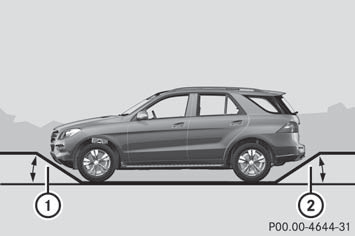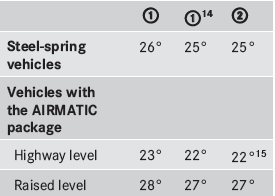Approach/departure angle


- Comply with the rules for off-road driving.
- Do not drive at an angle on slopes, inclines
or gradients, but instead follow the direct
line of fall. The maximum gradient-climbing
capability of your vehicle is 100%, which
corresponds to an approach/departure
angle of 45°. Note that the vehicle's
gradient-climbing capability depends on
the off-road conditions.
- Before tackling steep downhill gradients,
select shift range 1.
- Drive slowly.
- Avoid high engine speeds – drive at a
suitable engine speed (maximum 3000
rpm).
- When driving down an incline, make use of
the engine's braking effect. Observe the
engine speed; do not overrev the engine.
- Check the brakes after driving off-road for
a long time.
 WARNING
WARNING
Never turn the vehicle around on steep
inclines. The vehicle might roll over. If the
vehicle cannot complete the attempted climb,
back it down in reverse gear.
 Hill start assist will aid you when pulling
away on a hill.
Hill start assist will aid you when pulling
away on a hill.
For further information, see "Hill start
assist".
See also:
Parking
WARNING
PARKTRONIC and Active Parking Assist are
merely parking aids and may not detect all
obstacles. They do not relieve you of the
responsibility of paying attention.
You are always respon ...
Cup holders
Important safety notes
WARNING
In order to help prevent spilling liquids on
vehicle occupants and/or vehicle equipment,
only use containers that fit into the cup
holder. Use lids on o ...
Additives
Do not use any additives in the
engine oil.
This could damage the engine. ...
